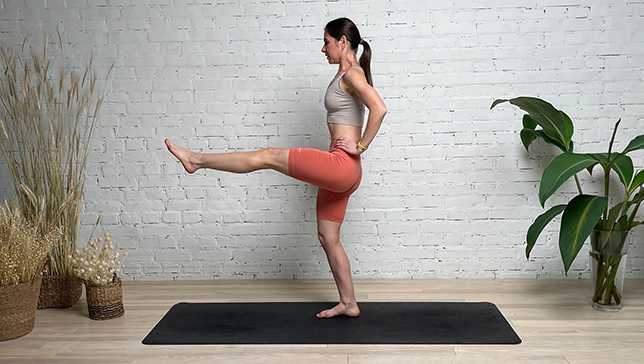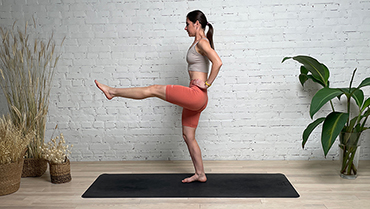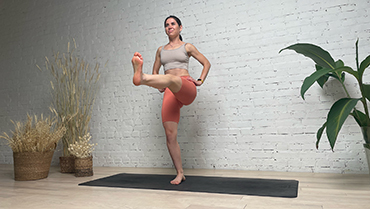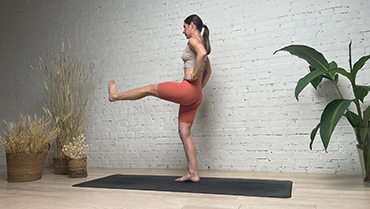One-Legged Mountain Pose - Eka Pada Tadasana

Contents
One-Legged Mountain Pose or Eka Pada Tadasana in Sanskrit, is a standing balancing yoga pose on one leg, and a variation of the simple Mountain Pose (Tadasana). At a beginner’s level of practice, this variation is generally part of the yoga sequence where the focus is to improve balance with simple standing yoga poses.
The likes of Eka Pada Tadasana (One Legged-Mountain Pose) are – Eka Pada Utkata Konasana (One Legged Goddess Pose), Flamingo Pose, Rooster Pose, Vrksasana (Tree Pose), etc.
Eka Pada Tadasana (One-Legged Mountain Pose) is considered a simple hip abduction. Strengthening the hips with the movements like flexion, extension, abduction, adduction, and external or internal rotation creates good support for the upper and lower body.
Yoga teachers should introduce at least one of these simple balancing yoga poses in the yoga sequence for improving balance and focus irrespective of the main theme or idea behind the yoga sequence. One-Legged Mountain Pose is considered a warm-up yoga pose to prepare the body for more intense yoga poses/yoga flows.
One-Legged Mountain Sanskrit
एकपाद ताडासन
The transliteration of Eka Pada Tadasana in English is “Eka Pada Tadasana.” In Sanskrit, “Eka” means “one,” “Pada” means “foot,” and “Tadasana” means “Mountain Pose.” Therefore, the Sanskrit name for Eka Pada Tadasana translates to “One-Legged Mountain Pose.”
Pose Detail
- By Type: Balancing Yoga Poses, Strengthening Yoga Poses
- Difficulty: Intermediate
- Body Position: Standing Yoga Poses
Step-by-Step Instructions
Benefits and Contraindications
Improves posture and balance.
Increases flexibility in hip joints, knees, and ankles.
Strengthens the abdominal muscles.
Injury at the hips, the knees, or the ankles.
Imbalance
Photo poses in different angles



Modifications, Variations and Props
One Leg Mountain is a balancing pose, so you first need to learn how to engage your stabilizer muscles.
If you have difficulty maintaining the balance, practice this against a wall. You can either face the wall and place your hands on the wall to maintain balance, or you can face away from the wall and use it to support your back.
Work on your core strength with plank variations and yoga crunches if balancing is hard for you.
Warm up your legs well before performing the asana.
Anatomy
One-Legged Mountain Pose, involves a complex interplay of muscles and joints in the body. Here are some of the key anatomical elements involved in the pose:
- Standing leg: The standing leg is responsible for providing a stable base for the pose. The quadriceps, hamstrings, glutes, and calves all work together to keep the leg straight and strong.
- Lifting leg: The lifting leg requires the activation of the hip flexors, including the iliopsoas and rectus femoris muscles. The glutes and hamstrings also play a role in lifting the leg and keeping it steady.
- Hips: The hips are a key area of focus in Eka Pada Tadasana. The pose requires hip flexion and external rotation on the lifted leg, as well as hip extension on the standing leg. The muscles involved in these movements include the hip flexors, glutes, and deep external rotators of the hip.
- Core:The core muscles, including the rectus abdominis, transverse abdominis, and obliques, work to stabilize the torso and maintain balance throughout the pose.
- Shoulders and arms: The shoulders and arms are involved in creating a sense of expansion and opening in the upper body. In the pose, the arm on the lifted leg side reaches forward while the other arm remains at the side.
Overall, Eka Pada Tadasana requires a strong and stable base, along with a focus on the core and hip muscles, to achieve balance and maintain the pose.
Frequently Asked Questions
Variations
- One-Legged Mountain Pose Leg Bent
- One-Legged Mountain Pose With A Chair
- One-Legged Mountain Pose Near The Wall
Top Preparatory Poses
Top Follow-Up Poses
- Standing Half Frog Pose
- Dancer Pose
- One Legged Revolved Mountain Pose
- Extended Hand-to-Big-Toe Pose